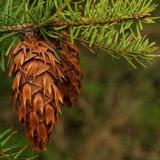 © Pete Saloutos/Panoramic Images (Washington Title Image Large)
© Pete Saloutos/Panoramic Images (Washington Title Image Large)

Canadian Rocky Mountains Vegetation
The Canadian Rocky Mountains ecoregion supports Rocky Mountain plants at the edge of their range in Washington. Alpine meadows, dense coniferous forests, riparian woodlands, and rolling grasslands are all found here.
At low elevation dry sites, forests of ponderosa pine and Douglas-fir are common. Moister, or mesic, sites find western red cedar, western hemlock, grand fir, and western white pine standing above an understory of lady fern and devil’s club. These forests share many species with the West Cascades and Puget Trough ecoregions.
High elevation forests consist of whitebark pine, western larch, and subalpine fir. The shrubby understory includes fool's huckleberry, Sitka alder, big huckleberry, and Cascade mountain ash. In areas of high snowpack, montane coniferous wetlands feed the region’s headwaters.
Along rivers, streams, and lakes, herbaceous wetlands are common. Black cottonwood and willows dominate the riparian zones along the Columbia and Pend Oreille.
Grasslands can be found on the lower foothills and on higher hillsides with southern exposures. Round Top Mountain is capped with a green fescue grassland that includes habitat for a pair of rare dryland sedges.
For details of this ecoregion within Washington, click a subheading in the left column.



